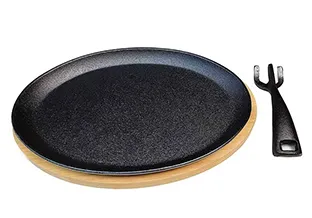
Ultimate Guide to Cooking with Cast Iron Pizza Skillets for Perfect Pizzas Every Time
The Joy of Cooking with a Cast Iron Pizza Skillet
When it comes to creating the perfect pizza at home, few tools can rival the unmatched versatility and durability of a cast iron pizza skillet. This kitchen essential not only provides a unique cooking surface but also enhances the flavors and textures of your favorite pizza recipes. If you’re looking to elevate your pizza-making game, investing in a cast iron skillet is a choice you will not regret.
Why Choose a Cast Iron Pizza Skillet?
First and foremost, cast iron skillets are renowned for their excellent heat retention and even distribution. Unlike traditional pizza pans, cast iron can withstand high temperatures, making it ideal for achieving that crispy crust that pizza lovers crave. When preheated, a cast iron skillet generates a beautifully golden-brown underside while allowing the toppings to cook evenly. The result? A pizza that rivals your favorite pizzeria.
Moreover, cast iron skillets are incredibly versatile. Not only can they be used for baking pizzas, but they can also be employed for a variety of other dishes, from skillet cookies to savory frittatas. This multifunctionality makes them a staple in any kitchen, catering to the diverse culinary interests of home cooks. And the best part? With proper care, cast iron skillets can last a lifetime, often becoming cherished family heirlooms passed down through generations.
Tips for Cooking Pizza in a Cast Iron Skillet
1. Preheat Your Skillet Start by preheating your cast iron skillet in the oven. A temperature of around 450-500°F is ideal for achieving that superb crust. Allow it to heat for at least 30 minutes before adding your pizza dough.
cast iron pizza skillet

2. Use Enough Oil To prevent sticking and to achieve that desirable crispy texture, add a generous amount of oil to the skillet before placing your dough in. Olive oil not only helps with the crust but also adds a delightful flavor.
3. Choose Your Dough Wisely Whether you prefer store-bought dough or making your own, aim for a thicker crust if you want to absorb some of the oil while achieving a satisfying chew. A thinner crust can also work beautifully, leading to a crunchier result.
4. Don’t Overload Your Toppings While it can be tempting to pile on multiple toppings, be cautious. Overloading can lead to a soggy pizza. Aim for a balanced distribution of sauce, cheese, and toppings for optimum results.
5. Experiment with Cooking Times Cooking time may vary based on the thickness of your crust and the toppings used. Keep an eye on your pizza; it should take around 15-25 minutes to cook. Look for a golden-brown crust and bubbling cheese as indicators that it’s ready.
The Final Touch
Once your cast iron pizza is out of the oven, allow it to cool for a few minutes before slicing. This brief waiting period lets the cheese set slightly, making for cleaner cuts and a more appealing presentation. Finish with a sprinkle of fresh herbs or a drizzle of balsamic glaze to elevate your pizza even further.
In conclusion, a cast iron pizza skillet can transform your pizza-making experience, providing you with enhanced flavors and textures that are hard to replicate with other tools. Not only does it create a restaurant-quality crust, but it also encourages creativity in the kitchen. So next time you crave a delicious homemade pizza, reach for that cast iron skillet and enjoy the many culinary adventures it has to offer!
-
Season Cast Iron Perfectly with GPT-4 Turbo TipsNewsAug.01,2025
-
High Quality Cast Iron Cookware - Baixiang County Zhongda MachineryNewsAug.01,2025
-
Premium Cast Iron Pan: Durable & Perfect HeatNewsAug.01,2025
-
High Quality Kitchen Durable Black Round Cast Iron Cookware Pancake Crepe Pan-Baixiang County Zhongda Machinery Manufacturing Co., Ltd.NewsAug.01,2025
-
Cast Iron Cookware - Baixiang County Zhongda Machinery | Nonstick, Heat ResistanceNewsAug.01,2025
-
High Quality Kitchen Durable Black Round Cast Iron Cookware - Baixiang County Zhongda Machinery | Non-Stick, Heat Retention, DurableNewsJul.31,2025


